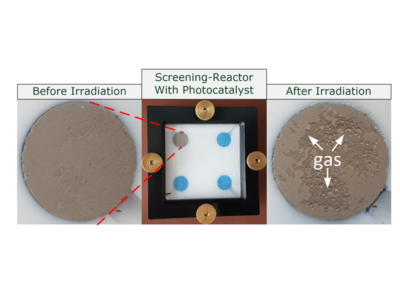Photocatalytic water splitting is a method to obtain hydrogen as an energy carrier from solar energy. Compared to fossil fuels, hydrogen can be converted without the formation of carbon dioxide, e.g. in fuel cells, for which hydrogen is considered as a clean energy source. Since the BMBF-funded joint project "Light2Hydrogen (2009-2014)", which was initiated by Prof. Matthias Beller (head of the Leibniz Institute for Catalysis eV, Rostock), hydrogen production via photocatalysis has been a focus of the work at the TU Berlin and in UniSysCat. It has been shown that such a complex topic can only be dealt with through the cooperation of different experts from fields such as material development on the one hand and technical development on the other.
Currently, Prof. Beller is editor of a special issue of the journal "Chemie, Ingenieur & Technik" and has invited UniSysCat’s spokesperson Prof. Arne Thomas for a contribution. We have put together a representative contribution, which on the one hand shows the cooperation of different research groups and on the other hand is dedicated to an important topic within photocatalysis: speeding up the work in the laboratory. Even though the development of suitable catalyst materials is the core of photocatalysis, all catalytic materials still need to be tested individually to identify promising candidates. This process is very time-consuming so far, especially because often much more materials are produced than test capacity is available and the expansion of the test capacity is associated with high costs. Our discussion about the simplification and acceleration of photocatalytic test methods resulted in a screening reactor, which is described in a new publication involving several UniSysCat research groups.
The screening reactor is intended to enable experimentalists to select suitable catalyst candidates for further investigations from a wide range of materials without any great effort or expense in terms of equipment. The measurement method is very simple and is based solely on the gas evolution at the interface between the photocatalyst and the liquid. For better handling, the different photocatalysts are fixed on a surface beforehand. The type of fixation is not prescribed and can be chosen flexibly. To validate the concept, the cooperation partners have provided their materials for investigation in the screening reactor. Currently, four catalysts can be studied in parallel with the setup, showing the same trends as already published in the literature – however, in a significantly shorter time. The influence of different key parameters of photocatalysis can be studied for different materials simultaneously. Thus, in principle, elaborate parameter studies can be carried out in just one experiment. Currently, a second generation of the screening reactor is under construction to expand the test capacity from four to nine samples.
This study has been published in Chemie Ingenieur Technik: Schwarze, M., Thiel, T.A., Rana, A.G., Yang, J., Acharjya, A., Nguyen, A.D., Tameu Djoko, S., Kutorglo, E.M., Tasbihi, M., Minceva, M., Huseyinova, S., Menezes, P., Walter, C., Driess, M., Schomäcker, R. and Thomas, A. (2022), Screening of Heterogeneous Photocatalysts for Water Splitting. Chemie Ingenieur Technik. https://doi.org/10.1002/cite.202200070

